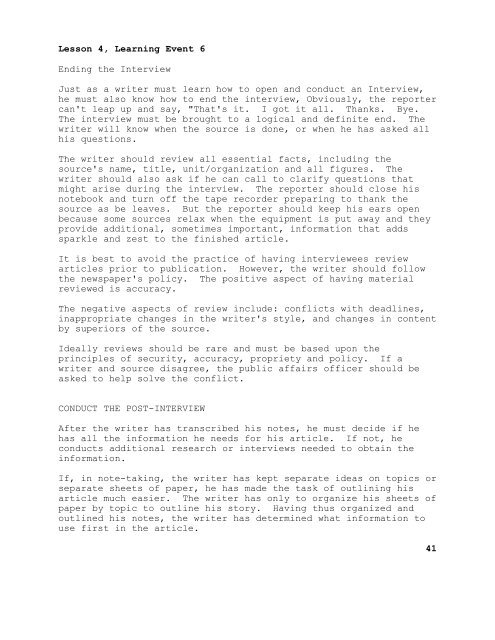US Army Journalist - Course - Survival Books
US Army Journalist - Course - Survival Books
US Army Journalist - Course - Survival Books
- No tags were found...
You also want an ePaper? Increase the reach of your titles
YUMPU automatically turns print PDFs into web optimized ePapers that Google loves.
Lesson 4, Learning Event 6Ending the InterviewJust as a writer must learn how to open and conduct an Interview,he must also know how to end the interview, Obviously, the reportercan't leap up and say, "That's it. I got it all. Thanks. Bye.The interview must be brought to a logical and definite end. Thewriter will know when the source is done, or when he has asked allhis questions.The writer should review all essential facts, including thesource's name, title, unit/organization and all figures. Thewriter should also ask if he can call to clarify questions thatmight arise during the interview. The reporter should close hisnotebook and turn off the tape recorder preparing to thank thesource as be leaves. But the reporter should keep his ears openbecause some sources relax when the equipment is put away and theyprovide additional, sometimes important, information that addssparkle and zest to the finished article.It is best to avoid the practice of having interviewees reviewarticles prior to publication. However, the writer should followthe newspaper's policy. The positive aspect of having materialreviewed is accuracy.The negative aspects of review include: conflicts with deadlines,inappropriate changes in the writer's style, and changes in contentby superiors of the source.Ideally reviews should be rare and must be based upon theprinciples of security, accuracy, propriety and policy. If awriter and source disagree, the public affairs officer should beasked to help solve the conflict.CONDUCT THE POST-INTERVIEWAfter the writer has transcribed his notes, he must decide if hehas all the information he needs for his article. If not, heconducts additional research or interviews needed to obtain theinformation.If, in note-taking, the writer has kept separate ideas on topics orseparate sheets of paper, he has made the task of outlining hisarticle much easier. The writer has only to organize his sheets ofpaper by topic to outline his story. Having thus organized andoutlined his notes, the writer has determined what information touse first in the article.41
















